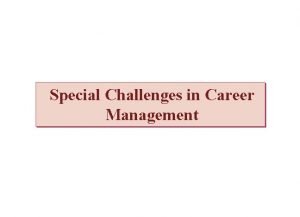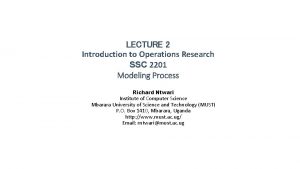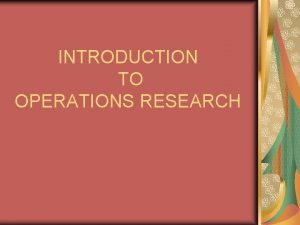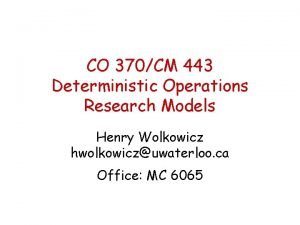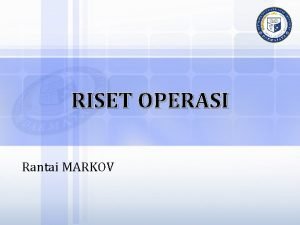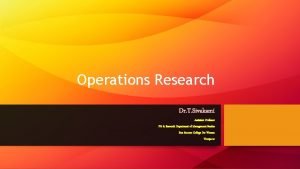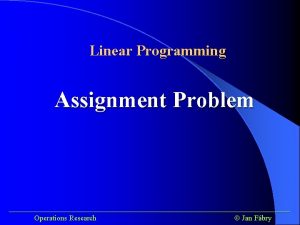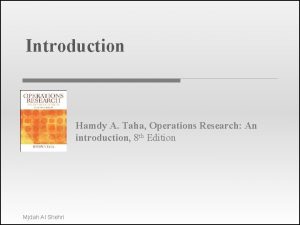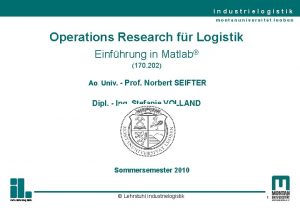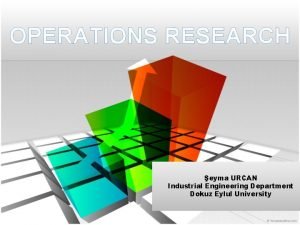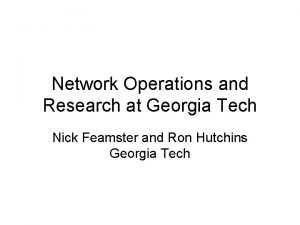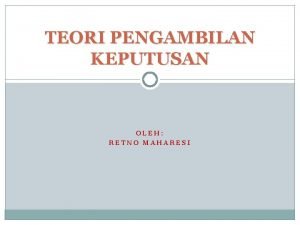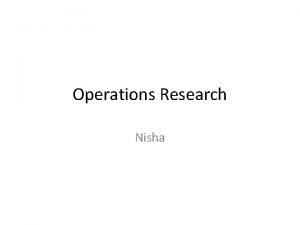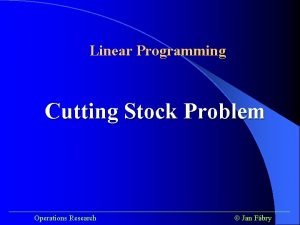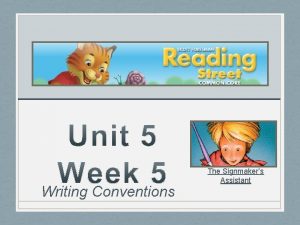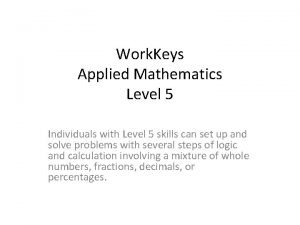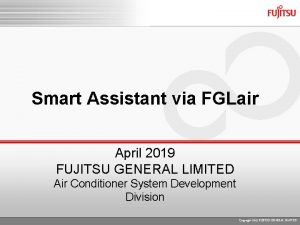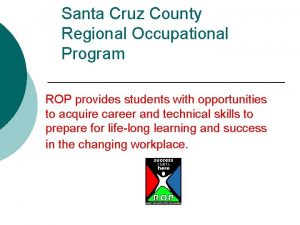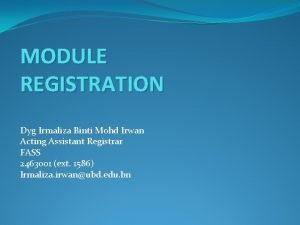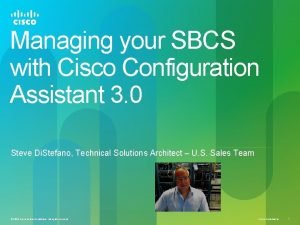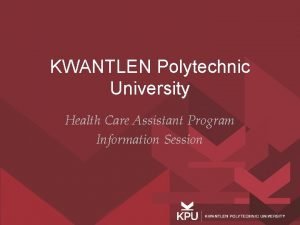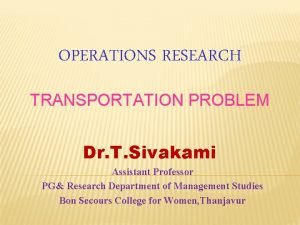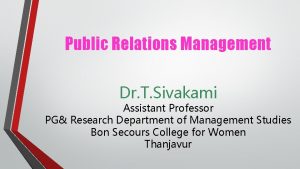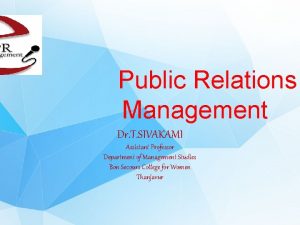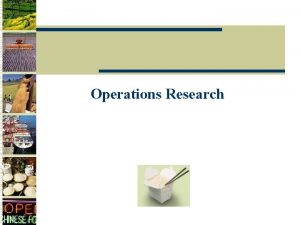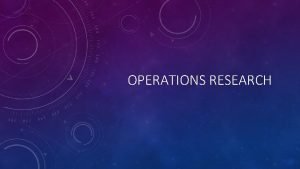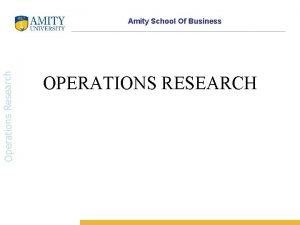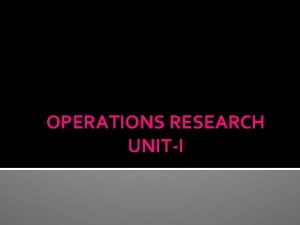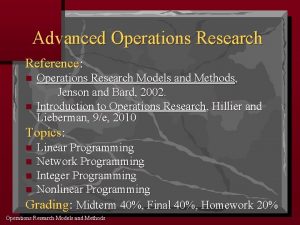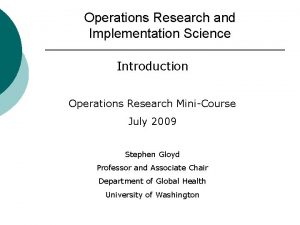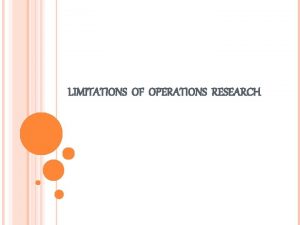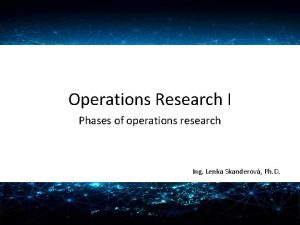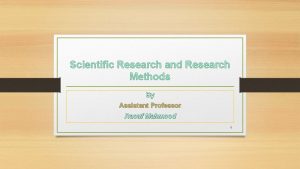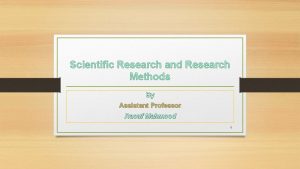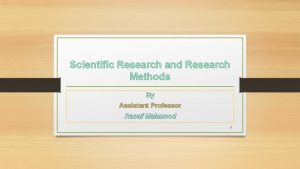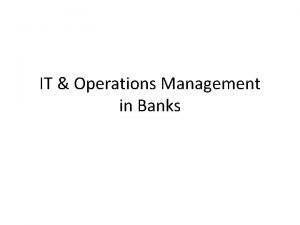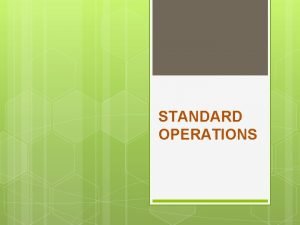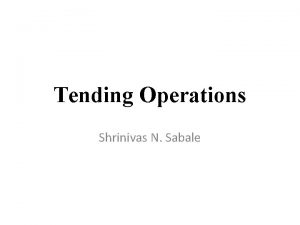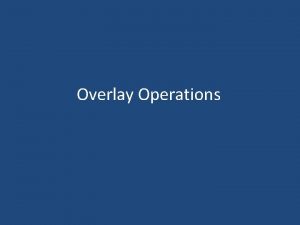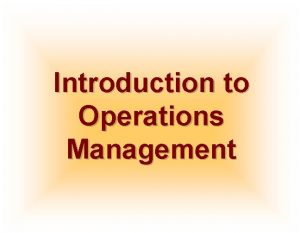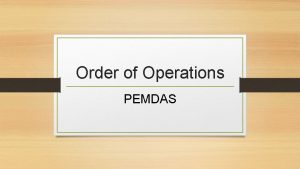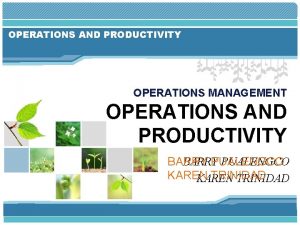Operations Research Dr T Sivakami Assistant Professor PG























- Slides: 23

Operations Research Dr. T. Sivakami Assistant Professor PG & Research Department of Management Studies Bon Secours College For Women Thanjavur

Operations Research • Definition • Models • Scope • Phases • Advantages • Limitations • Tools/Techniques in OR • Characteristics

Definition • “Operations Research is the art of giving bad answers to problems which otherwise have worse answers” - T. L. Satty • “Operations Research is applied decision theory. It uses any scientific, mathematical or logical means to attempt to cope with the problems that confront thw executive, when he tries to achieve a thorough- going rationality in dealinig with his decision problems” -D. W. Miller & M. K. Starr

MODELS OF OPERATION RESEARCH Iconic Models Analogue Models Mathematical (Symbolic)Models • Eg: A Child’s toy, A photograph • A histogram, A schedule of operations • Graphs and maps in various colours • Demand curves and flow charts in production control • To represent the components and relationship between the real system

Iconic Models • Iconic models are pictorial representation of real systems and have the appearance of the real thing. • They are “look- like” items to understand interpret. • Easy to observe , build and describe, and difficult to manipulate.

Analogue Models • • Analogue models are more abstract than the iconic models. They are built by utilizing one set of properties to represent another set of properties. These models are easy to manipulate and can represent dynamic situations More useful than iconic because to represent the characteristics of the real system under investigation.

Mathematical( Symbolic) Models • Most abstract in nature. • Most general and precise. • It is not always possible to depict the real system.

Other Types of Models Combined Analogue and mathematical Models Allocation Models Function Models Sequencing Models Quantitative Models Network Models Qualitative Models Inventory Models Simulation Models Replacement Models

Scope of Operation Research Defence Services R&D and Engineering National Planning & Budgeting Education & Training Industrial Sector Agriculture & Irrigation Transportation Home Management & Budgeting Business Management & Competition Useful to Financial Controller Useful to Production Specialist

Phases of Operations Research First Phase Second Phase Formulating Constructingthethe. Problem Model Third Phase Deriving the Solution Fourth Phase Updating the Model Fifth Phase Controlling the Solution Sixth Phase Implementing the Findings

Advantages Optimum Use of Production Factors Preparation of Future Managers Alternative Solutions Improved Quality of Decision Modification Mathematical Solutions

LIMITATIONS 1 • Money and Time Cost • Practical Applications 2 • Not- Realistic • Reliability of the proposed solution 3 • Implementation • Complex • Non-quantifiable Factors

Money and Time Cost: Operations Research (OR) is very costly. The Basic data is subject to frequent changes , the cost of changing programme manually is a costly affair. • Practical Applications: Formulation of an Industrial problem to an OR programme is a difficult task.

• Not Realistic : OR experts make very complex models for solving problems. These models may not be realistic. Hence, they may not be useful for real-life situations. • Reliability of the proposed Solution: A Non-Linear relationship is changed to linear for fitting the problem to linear programming pattern. This may disturb the solution.

• Implementation: Implementation of decisions is a delicate task. It must take into account the complexities of human relations and behaviour. • Complex : OR is very complex concept. It is very difficult for an average manager to understand it. Therefore, most managers do not use OR techniques.

Tools / Techniques in OR • Linear Programming: This is a constrained optimization technique, which optimize some criterion within some constraints. In Linear programming the objective function (profit, loss or return on investment) and constraints are linear. • Decision Theory: Decision theory is concerned with making decisions under conditions of complete certainty about the future outcomes and under conditions such that we can make some probability about what will happen in future.

Tools / Techniques in OR • Game Theory: This is used for making decisions under conflicting situations where there are one or more players/opponents. In this the motive of the players are dichotomized. The success of one player tends to be at the cost of other players and hence they are in conflict. • Inventory Models: Inventory model make a decisions that minimize total inventory cost. This model successfully reduces the total cost of purchasing, carrying, and out of stock inventory. • Simulation: Simulation is a procedure that studies a problem by creating a model of the process involved in the problem and then through a series of organized trials and error solutions attempt to determine the best solution.

Tools / Techniques in OR • Non-linear Programming: This is used when the objective function and the constraints are not linear in nature. Linear relationships may be applied to approximate non -linear constraints but limited to some range, because approximation becomes poorer as the range is extended. Thus, the non-linear programming is used to determine the approximation in which a solution lies and then the solution is obtained using linear methods. • Dynamic Programming: Dynamic programming is a method of analyzing multistage decision processes. In this each elementary decision depends on those preceding decisions and as well as external factors.

Tools / Techniques in OR • Network Scheduling: This technique is used extensively to plan, schedule, and monitor large projects. The aim of this technique is minimize trouble spots (such as delays, interruption, production bottlenecks, etc. ) by identifying the critical factors. The different activities and their relationships of the entire project are represented diagrammatically with the help of networks and arrows, which is used for identifying critical activities and path. There are two main types of technique in network scheduling, they are: • Program Evaluation and Review Technique (PERT) – is used when activities time is not known accurately/ only probabilistic estimate of time is available. • Critical Path Method (CPM) – is used when activities time is know accurately.

Tools / Techniques in OR • Markov Process: Markov process permits to predict changes over time information about the behavior of a system is known. This is used in decision making in situations where the various states are defined. The probability from one state to another state is known and depends on the current state and is independent of how we have arrived at that particular state. • Information Theory: This analytical process is transferred from the electrical communication field to O. R. field. The objective of this theory is to evaluate the effectiveness of flow of information with a given system. This is used mainly in communication networks but also has indirect influence in simulating the examination of business organizational structure with a view of enhancing flow of information.

Characteristics of OR • Inter-disciplinary Team Approach: Basically the industrial problems are of complex nature and therefore require a team effort to handle it. This team comprises of scientist/mathematician and technocrates. Who jointly use the OR tools to obtain a optimal solution of the problem. The tries to analyse the cause and effect relationship between various parameters of the problem and evaluates the outcome of various alternative strategies. • System Approach: The main aim of the system approach is to trace for each proposal all significant and indirect effects on all sub-system on a system and to evaluate each action in terms of effects for the system as a whole. The interrelationship and interaction of each sub-system can be handled with the help of mathematical/analytical models of OR to obtain acceptable solution.

• Use of Computers: The models of OR need lot of computation and therefore, the use of computers becomes necessary. With the use of computers it is possible to handle complex problems requiring large amount of calculations. • Decision-making: Every industrial organisation faces multifacet problems to identify best possible solution to their problems. OR aims to help the executives to obtain optimal solution with the use of OR techniques. It also helps the decision maker to improve his creative and judicious capabilities, analyse and understand the problem situation leading to better control, better co-ordination, better systems and finally better decisions. • Scientific Approach: OR applies scientific methods, techniques and tools for the purpose of analysis and solution of the complex problems. In this approach there is no place for guess work and the person bias of the decision maker.

THANK U
 Promotion from assistant to associate professor
Promotion from assistant to associate professor Cuhk salary scale 2020
Cuhk salary scale 2020 Dual career paths
Dual career paths Scope of operations research
Scope of operations research What is operation research
What is operation research Deterministic operations research
Deterministic operations research Markov chain operations research
Markov chain operations research Iconic models in operations research
Iconic models in operations research Operations research
Operations research Taha operations research
Taha operations research Operations research logistik
Operations research logistik Operations research topics
Operations research topics Georgia tech operations research
Georgia tech operations research Rumus kriteria laplace
Rumus kriteria laplace Significance of operations research
Significance of operations research Linear programming in operations research
Linear programming in operations research What are writing conventions
What are writing conventions Workkeys applied mathematics level 5 answers
Workkeys applied mathematics level 5 answers Juliette southard
Juliette southard Fujitsu home assistant
Fujitsu home assistant Medical assistant program rop
Medical assistant program rop Assistant registrar ubd
Assistant registrar ubd Cisco configuration assistant 3.2 download
Cisco configuration assistant 3.2 download Kpu health care assistant
Kpu health care assistant


